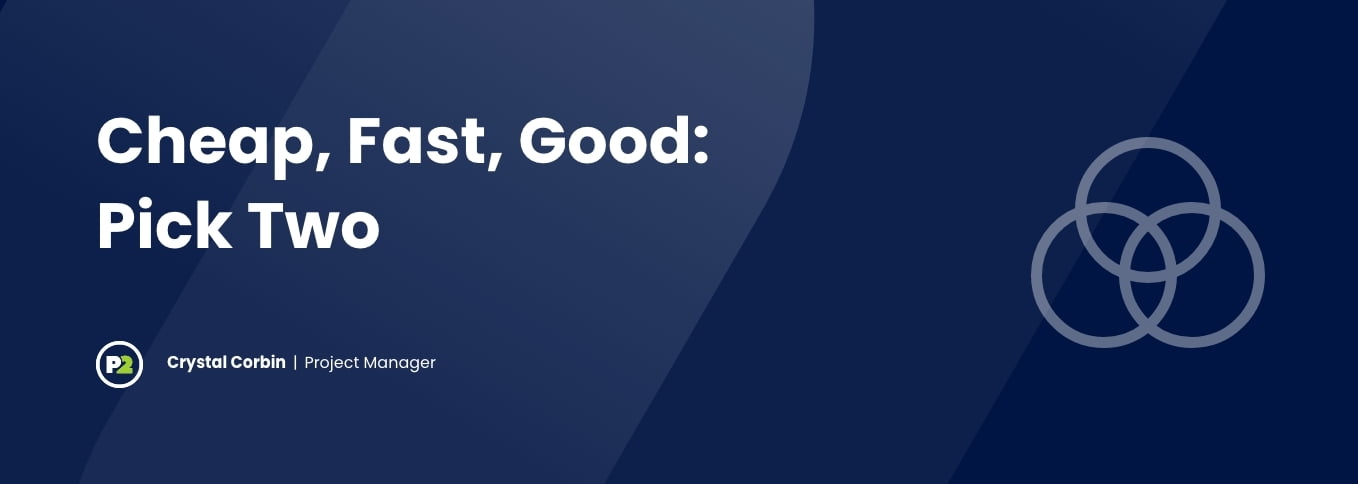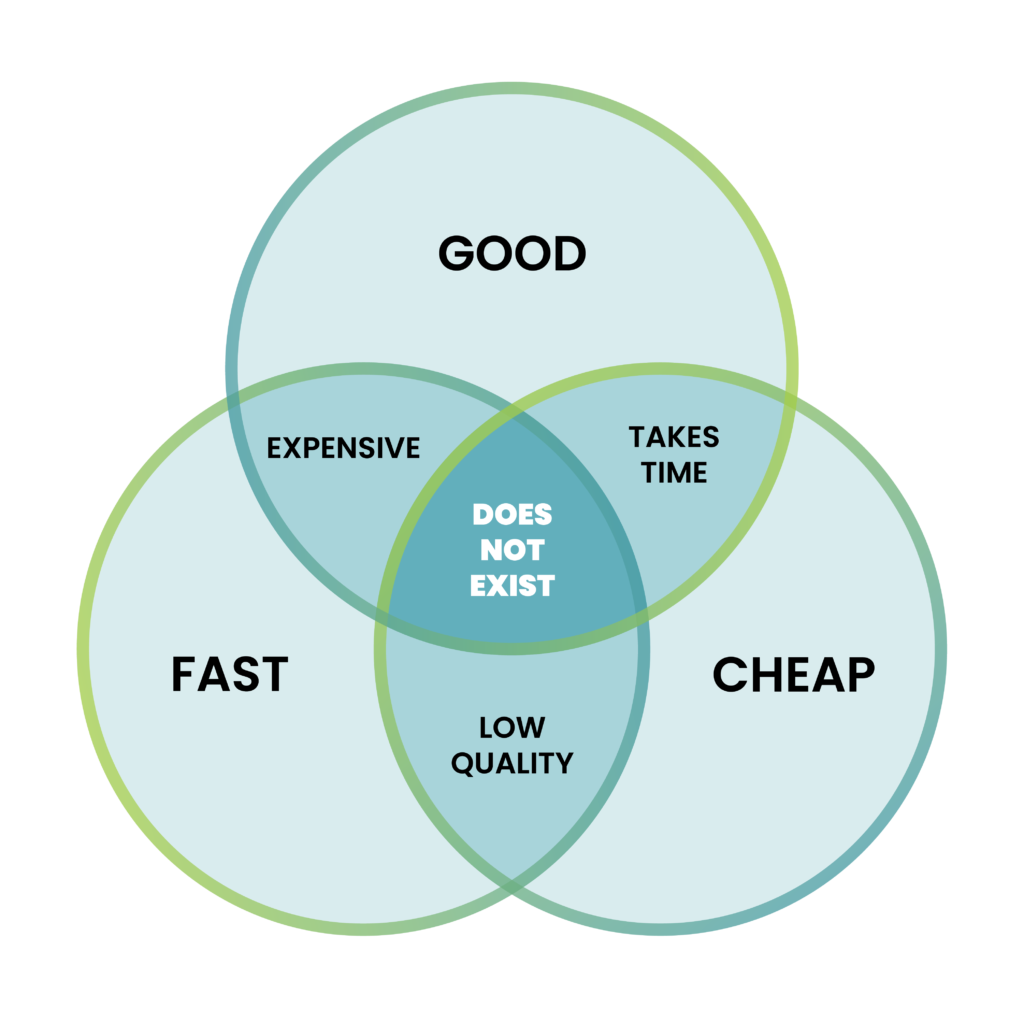
Cheap, Fast, Good: Pick Two
Have you ever heard the expression, “you can have it cheap, fast or good – choose two”? This is an important concept to remember when contracting work out, especially software development. Here, we explain why the two options you choose are important and why you can’t have all three.
In today’s society, everyone wants things immediately. Instant gratification is trending to the point of being a way of life (thanks, Amazon Prime.) The faster we get something, the better. As new businesses start up daily, time to market is a very critical piece of the initial business model. Business owners want to make sure they get their idea out to the consumer first before someone else comes along with a more refined offering.
When we look at the three options, people usually want to say, “I want all three.” But, unfortunately, that just isn’t realistic or really possible. We found this handy tool to help illustrate this ideology from FastGood.Cheap. Try picking all three: fast, cheap, good.
Widget credit: FastGood.Cheap
How did that go, could you pick all three? No, because it isn’t a rational request to ask of any development firm. Some would counter this by saying they have a friend that is a programmer and he is going to do it for them, but – again – there’s always a trade off. Let’s dive into each piece a bit.
Cheap
Cheap is usually associated with low cost or minimal dollars spent to get the product completed. In most cases, this is a driving factor. Startups that don’t have funding or steady revenue obviously want to be as frugal as possible. Their idea may or may not be successful or it could become obsolete before they get it to market. That could mean wasted money for themselves and/or their investors.
Fast
Getting a product out the door quickly and into the hands of customers is always the desire. The sooner it is in customers’ hands, the sooner you start to get revenue and, hopefully, profits. Getting to market before your competitors gives you an edge. However, there are many pitfalls with fast. Some pitfalls that can doom a product are too many bugs or lack of overall polish that turns customers off, just to name a couple.
Good
We all want a good product. This can be interchanged with “quality.” The quality speaks to you as a company, as a brand. Business owners typically don’t want to be known for low-quality products or services. Business owners can have “good ideas” but it is the quality of the execution that customers care about – and what they’ll stick around for.
Going back to the expression, “you can have it cheap, fast or good – choose two”, hopefully you can start to see how it really is NOT possible to have all three options.

Cheap + Fast
If we choose cheap and fast, the likelihood is that the quality will suffer. While the speed your engineers are working at will keep costs down, it will probably mean they cut corners or make mistakes. How often have you sped through something with 100% accuracy?
A good example of cheap and fast that comes to mind is the Ford Pinto. This car was rushed into the market with a poor fuel tank design that would cause the vehicle to explode or burst into flames in low impact rear-end crashes. The company was aware of this defect, but still chose to cut corners for profit. The car was finally recalled in 1978 after being in production for several years, but not before killing and severely burning many of their customers.
Cheap + Good
If we choose cheap and good, it probably won’t be fast. To get cheap and good, you will probably be hiring a “green” person/business, a newbie. They want to put out quality work to build their own brand. But because they lack experience, it’s going to take them a lot longer to complete.
The Marvel Cinematic Universe (MCU) is a great example of cheap and good. Marvel didn’t cast top dollar actors in its movies and took their time in creating the MCU. Audiences spent four years learning about the superheroes who would eventually become the Avengers. Taking the time for character development turned out to be a key factor in their success as a franchise. That risk has reaped billions in rewards and has led to many of the Avengers renegotiating their salaries. Unfortunately on the other side of the coin, the same cannot be said for the DC Universe. While this brand spent a lot casting top dollar actors to build the Justice League, they cut corners on every other budget line. This led to rushed production, poor character development and scripting, and ultimately lower popularity and sales.
Fast + Good
Choosing fast and good, without question, will not be cheap. To find a developer – or any professional – who can deliver work in a short time with high quality means you’ll pay for their skill and experience. Those are not cheap. To get high-quality work that hits your deadline means you need top dollar talent.
The best example of fast and good is smartphones. Every year Apple and Samsung launch the latest and greatest smartphones. Each company offers better features and technology topping their last release and rivaling each other to increase market share. They are able to achieve this by hiring experienced innovative designers and developers to help elevate their products to the next level in the speed in which they need to get to market. For these companies, the cost does not outweigh the benefit.
In conclusion, when you are starting up a new project – software, branding, websites, landscaping – keep these things and Phase 2 in mind. Ask yourself what is important and relevant to your needs, but most importantly… choose wisely. Want to know more about starting a custom software project? Our president Heath Clinton gives more insight to what to expect here.
